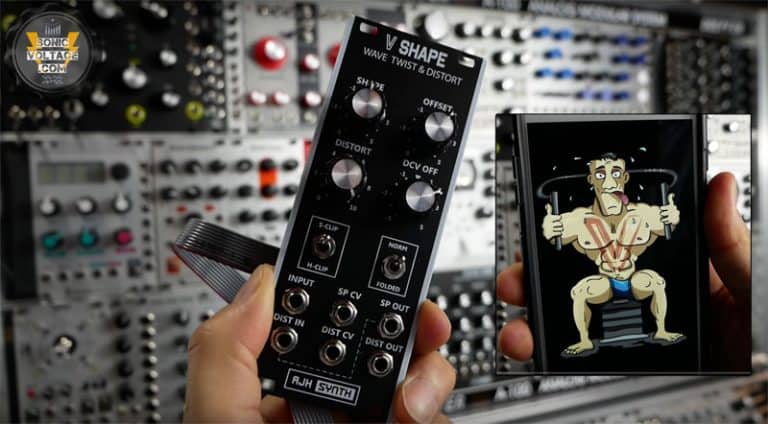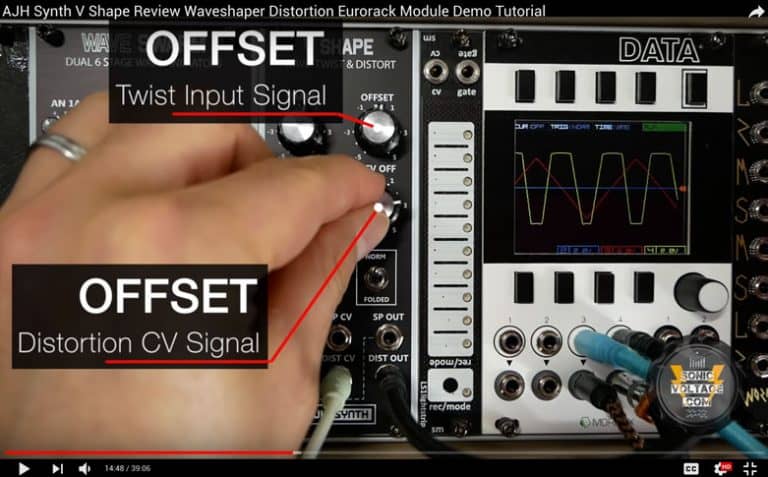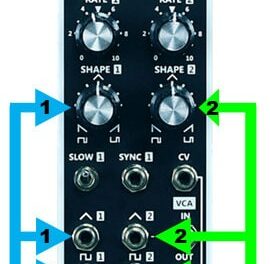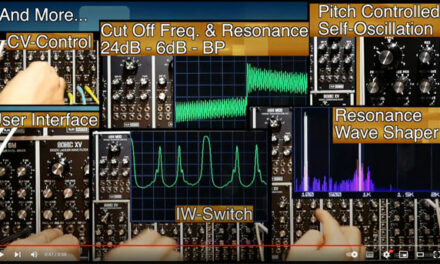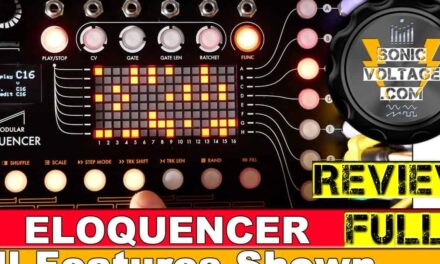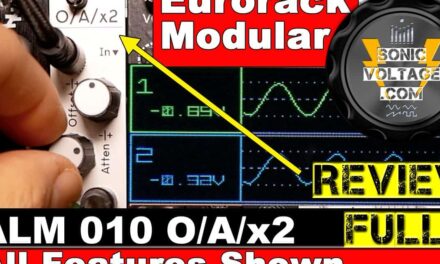At the top, you have a Wave Twist or Wave Skewer unit with an Input, a CV Input for CV control over the Shape Skewing, an Offset control knob and a dedicated Output.
The unit below is a Distortion module with a switch to choose between Soft or Hard Clipping. CV Input for CV Control over Distortion. Distortion CV Offset Control and a dedicated Distortion Unit Output. There is also a single-stage Wavefolder you can Switch In, which will, of course, add folding to your signal.
For a quick overview of the AJH Synth V SHAPE’s features check out the beginning section of the review video where we also send a SAW Signal for some initial Twisting and Distorting. You will see that modulating the Twist via CV Control can give us something like PWM but applied to SAW and other shapes.
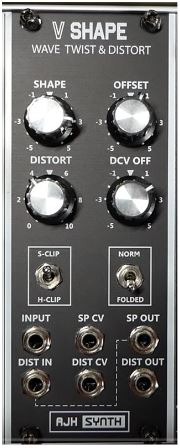
You can use each section individually, which means:
- you can send a signal to the Wave Twist’s Input, skew it and take the processed signal at the SP Out output. You can add Skew modulation with the SP CV Input
- Send a different signal to the input of the Distortion unit, process it, add wavefolding if you want and take this distorted signal from the DIST OUT output. You can add modulation via the DIST CV Input
Or you can use both units of the V SHAPE in a Cascaded mode where the output of the TWIST unit is normalised (internal connection) into the Input of the Distortion unit. This way you have one signal present at the INPUT connector, skew it, add distortion, CV control, soft or hard clipping, maybe switch ‘ON’ the Wavefodler and take the overall processed output at the DIST OUT point. In the cascaded mode, you are twisting, distorting, clipping, and folding maybe with added dual CV control on a single sound.
Keep in mind that in the cascaded mode, you can still take the SP OUT and the DIST OUT individually, at the same time. One input but you get two different sounding outputs which open things up for further processing via other modules of two related signals.
What Type Of Signals Can You Process Through The AJH Synth V SHAPE?
In the video (at 8:24 min) you can see how several different waveforms are being passed through the AJH Synth V SHAPE and how you can get usable and interesting results with all sorts of waveforms apart signals that are a good approximation of a square wave.
A signal with really steep leading/falling edges and not much voltage variations (e.g. Squarewave) is not going to give you much through the V SHAPE, but anything else… Party Time!
A Few More Words About The Two Units And CV Control
The process applied to the Input signal does tend to add some harmonic content, and it is wave-source dependent, which makes it even more interesting to play with and try on different waveforms.
At the output of the Twister Section, there is always some of the inverted signal mixed in. This means the output waveform is between 10% and 90% duty cycle and the available documentation does mention that the circuit sort of expects an incoming waveform of exactly 10V peak to peak with bias centred at 0 volts. The cool thing is that when the waveform you send to the input is not characterised by these exact values (10V pp and Zero V Bias…) the V-Shape will give you some Non-Linear Distortion and this non-linear-distortion together with this Offset Control allows you to generate a wide range of sounds.
You can also add an offset which allows you to centre the input wave around zero-value or push further away from zero-value (in the positive or negative direction) to get more distortion and harmonic content.
For the Distortion module, you can use CV Control over the Clipping amount and use the DCV Offset control knob to set a level for the CV Signal to work from. This is very useful because by adding/subtracting Voltage to/from the CV-Signal you can get a good range of control… That’s good.
The Distortion Section will… yeah, you guessed it, add distortion to the signal, but the specific case with the V-Shape distortion is one where the Output is attempted to be kept a unity gain, therefore, adding distortion will not vary the output level by a lot and it does this even better in Hard Clipping mode. This means that with the V-Shape you can have some Voltage Controlled distortion and grunginess added to your input waveform without worrying about big changes in Output Level!
It’s Time To Get Our Hands Even Dirtier And “V SHAPE” A Few More Patches
The following AJH Synth V SHAPE Patches show additional description in the Video
20:49 Video: A Pittsburgh Modular Lifeforms Double Helix Oscillator bass patch. A mix of Saw and Sine from the Double Helix (synth voice) was sent through the V Shape TWIST section. A sort of LPG Bass Sound…
21:47 Video: We then use both V SHAPE channels individually. We added a Tonestart 2600 Synth lead part to the previous Bass/Beat patch.
- The Bass voice passes through the V Shape SHAPE unit
- The Tonestar Synth Voice (mix of onboard waves) goes through the Distortion unit.
In this video, you can hear how the Distortion and Wavefolder add intensity and character to the Lead sound double notes
23:45 Video: Let’s try now with a Kick going through the V Shape units. Kick is from the Hexinverter Mutant Bassdrum. Signal flow is ‘cascaded’. Input at the SHAPE unit, through to the Distortion unit then out of the DIST OUT. We play around with Distortion level, soft and hard clipping, Wavefolder, CV, etc…
26:31 Video: Well, we checked the Kick, we got to check the Snare too.
V Shape on the Hexinverter Mutant Snare
Cascaded with Input at the SHAPE unit, through to the Distortion unit then OUT. Some V Shape knob tweaking.
28:10 Video: This time around we pass the whole beat Kick, Snare and Hats, through the V Shape and we take both SP and DIST out to process one of the outputs with the Finaliser R-EQ. Then mix them back together as they are recorded.
Kick, Snare and Hats MONO MIX into V Shape Input
This time we use both Outputs.
- Shape Output goes mono into the AJH Synth Finaliser R-EQ (Stereo Out to DAW)
- Distortion Output goes straight to DAW
30:28 Video: Birdkids Bateleur sent through the V Shape and the Finaliser R-EQ for a strange type of sound. Some will hate it some will think it’s funny 🙂 – It’s just a sound being processed 🙂
It’s a mix of Sine, Triangle and Saw (Bateleur wave outputs) going through the Bateleur’s own Filter section. Erogenous Tones VC8 and Levit 8 for VCA and level additional level boost/control.
Again we take both outputs from the V Shape:
- SP OUT goes to the Finaliser for EQ and Reverb, we go mono in and stereo out on the Finaliser
- DIST OUT straight to DAW
31:12 Video: Another Patch making use of both Shape and Distortion units as individual processing channels
- Double Helix through SHAPE Unit (Bass)
- Tonestar 2600 through Distortion Unit (Lead)
Tone variations playing around with V-Shape controls, wave folder and Input Signal Amplitude (Non-Linear Distortion, which is cool!)
AJH Synth V SHAPE Review: Conclusion
Before some final consideration, remember to let me know your thoughts about this module in the comments below, comments under the video and please click on Like 🙂
Share this page if possible and Subscribe to the YouTube Channel for more videos… that would be great!
The V-Shape can go from that twisting, wobbly sound to non-linear, aggressive distortion and that’s just the top unit in the module, and you do get variations depending on the amplitude and offset of the source sound and the actual source sound type.
The Distortion module gives you nice and warm, analogue clipping at unity gain.
The Wavefolding adds variations to your choice of soft or hard clipped signal.
You get flexibility in terms of signal flow. You can use the two units independently from each other or send ‘one’ Input Signal through both units to apply both analogue processors to your signal and you can still take the Twist Output separately from the Cascaded processed sound which allows you to further process these two output signals and then maybe recombine them later in your mix with added mono, stereo, panning choices if you want (via your additional modules)
I think this is a nice amount of analogue processing power to have in a quality built 10HP module. I will surely be using the V Shape in my main Monster Cases setup and it should be just perfect for my 7U case to get some analogue distortion with me when on the move!
AJH Synth V SHAPE Wave Twist & Distortion
10HP Wide
26mm deep (Including power lead)
75mA Positive
45mA Negative
Modules Used In This Eurorack Review And Patch Demos
Abstract Data Octocontroller ADE 32
Mutable Instruments Branches
Orthogonal Devices ER-101 – Review
Birdkids Bateleur
Pittsburgh Modular Lifeforms Double Helix Oscillator
AJH Synth WAVE SWARM Review
AJH Synth Finaliser R-EQ Review
Xaoc Batumi
Division 6 Multiplicity XV
Mordax DATA
Erogenous Tones VC8
Erogenous Tones Levit8
Hexinverter Mutant Bassdrum
Hexinverter Mutant Snare
Analogue Solutions HH88
If you find this post useful I would appreciate it if you could SHARE it (Forums, Facebook, Twitter, Instagram, etc…). It would help me a lot. And sharing will also tell me these reviews are being of some use to the readers which in turn pushes me to produce more reviews. Feel free to comment, ask questions below or leave comments under the video review and Subscribe to SonicVoltage YouTube Channel, I’ll do my best to reply.
Ok, people! Thank you for stopping by and/or watching the video review.
Until next time… Happy Euroracking, Have Fun!


